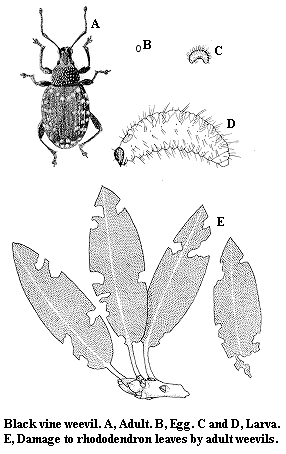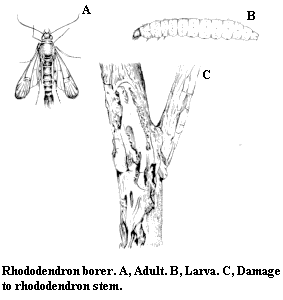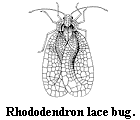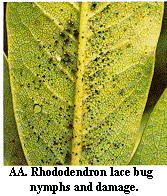Key to Rhododendron
Close to 4,056,000 rhododendrons are grown or collected by Southern nurserymen each year. Although sometimes difficult to maintain in the Piedmont and Coastal Plain, rhododendrons are highly desirable landscape plants because of their attractive flowers, variable growth habits, and leaf texture and color. Rhododendrons are not highly susceptible to insect pests, but they are occasionally beset by rhododendron borers, rhododendron lace bugs, and two kinds of weevils.
- Rhododendron borer – Heavily infested branches weak, breaking easily; leaves wilt and turn brown; holes in infested branches with fine sawdust; white caterpillars in tunnels.
- Rhododendron lace bug – Chlorotic spots on upper leaf surface, numerous dark spots of insect excrement on lower leaf surface; small, dark, spiny insects and slightly larger (3-mm), lacy insects on lower leaf surface.
- Rhododendron tip midge – New growth distorted, leaf margin curled under tightly; small (1.3-mm) maggots inside cavity formed by curled margin.
- Weevils – Leaves notched on margin, sometimes wilting during hot weather; eventually heavily infested plants may die.
- Black vine weevil – Damage to leaves done late at night; white grubs feeding on roots during growing season; adult weevil is black .
- Japanese weevil – Damage to leaves occurs during daylight; larvae are white grubs, which probably feed on the roots during the growing season
Black Vine Weevil
Black vine weevil, Otiorhynchus sulcatus (Fabricius), Curculionidae, COLEOPTERA
DESCRIPTION
Adult – The oblong black vine weevil is 10 to 11 mm long and has a short snout. The elytra possess many rounded tubercles, each with a short seta. The body is blackish brown; the antennae are black and slightly pubescent; and the head is smoother than the thorax (Figure J).
Egg – The egg is approximately 0.7 mm in diameter, with a smooth, shiny surface. It is white when first deposited but becomes brown as it ages.
Larva – As the legless larva matures, thickening thoracic segments cause its body to become curved. The fully grown larva is dirty white with a brown head.
Pupa – The pupa is white with prominent dusky spines on the head, abdomen, and legs.
BIOLOGY
Distribution – The black vine weevil has the name "vine" in its common name because it was first recognized as a pest of grapes in Germany in 1934. About 1910 the beetle was found in Connecticut and has since become a serious ornamental pest in southern Canada and the northern United States.
Host Plants – Many herbaceous and woody plants have been listed as hosts for the black vine weevil. Some of the preferred woody hosts include hemlock, rhododendron, and yew.
Damage – Black vine weevil larvae can stunt the growth of a plant by feeding on the roots. Larger roots are stripped of their bark or girdled, or they have notches chewed out of them. The adult weevils chew the edges of the leaves, cut off the tips of needles, or devour entire needles (Figure J). The interior, older foliage is preferred to the terminal growth.
Life History – Black vine weevils overwinter as mature larvae or as pupae. However, a few adults also survive the winter to feed and deposit eggs during a second season. This weevil is parthenogenetic. Although one female was recorded as laying 863 eggs, the average number of eggs deposited by each female is probably about 200. During the preoviposition period, which lasts about 45 days, the adults feed most extensively. The longevity of the adult usually ranges from 90 to 100 days. Eggs, deposited in the soil and leaf litter, hatch in 2 to 3 weeks. Initially the young larvae feed on rootless; but after the third molt, the larvae move to the larger roots. During their development, the larvae molt five or six times within earthen cells in the soil constructed by the larvae prior to molting. After a quiescent prepupal stage that lasts from 3 weeks to 8 1/2 months, the larvae pupate. Three weeks later, adults emerge. Adults feed at night and drop from the plant, feigning death when disturbed. These weevils cannot fly; so they must be carried or must crawl to uninfested areas.
CONTROL
For specific chemical controls, see the current state extension recommendations.
Rhododendron Borer
Rhododendron borer, Sqnanthedon rhododendri Beutenmuller Sesiidae LEPIDOPTERA
DESCRIPTION
Adult – The rhododendron borer moth has a black head with green and white markings. The thorax is black and blue with a broad patch of pale yellow or shiny white on each side. The abdomen is also black and blue with segments two, four, and five trimmed with yellow dorsally; segments three through six are yellowish on the underside. The legs are yellow and white epically and dark basally with some light-colored markings. The wings are transparent with a rusty-black fringe and some yellow scales. There is a tuft of black and yellow scales at the tip of the abdomen. The female has broader bands on segments two, four, and five than the male does. The female's anal tuft is short and rounded, whereas the male's is fan shaped. One of the smallest members of the family of clearwing moths, this moth has a wingspan of 10 to 15 mm.
Larva – The yellow-white larvae are caterpillars about 13 mm long.
BIOLOGY
Distribution – The rhododendron borer is found in the mountains of the Atlantic Coast states wherever rhododendron grows abundantly. This moth is indigenous to the United States.
Host Plants – Rhododendron is the principal host for the rhododendron borer. Mountain laurel and azalea are also attacked.
Damage – Twigs and small branches are preferred by the rhododendron borer. Infested branches become weakened and may break off. Leaves on infested branches often turn brown. Occasionally older parts of the shrubs are attacked. The main trunk may have numerous holes with fine sawdust protruding from them. Past infestations on older plant parts will appear as shallow, longitudinal grooves in the bark.
Life History – Adults emerge from their pupation sites during May and June and deposit eggs on twigs. Newly hatched larvae bore into stems and dig long tunnels in the soft pith. The tunnels become filled with small, reddish fecal pellets and serve as sites for overwintering and spring pupation.
CONTROL
Pruning infested branches helps to control the rhododendron borer. For specific chemical controls, see the current state extension recommendations.
Rhododendron Lace Bug
Rhododendron lace bug, Stephanitis rhododendri Horvath, Tingidae, HEMIPTERA
DESCRIPTION
Adult – The small adult, about 3.5 mm long and 2.4 mm wide, has lacy wings that are unusually broad. It is pale yellow, with yellowish legs and antennae.
Egg – The yellowish-white egg is 0.4 mm long and 0.2 mm wide. Basically cylindrical, it is tapered at both ends, with the neck bent to one side. The eggs are deposited in irregular rows, usually along the larger veins. Their caps are level with the leaf surface. The females deposit a brown substance over the eggs, which hardens to form a varnish-like covering.
Nymph – Unlike most lace bugs, the rhododendron lace bug has only four nymphal stages. The nymphs feed in groups in the younger stages. They range from 0.9 to 2.1 mm in length and are black and spiny (Color Plate 3AA).
BIOLOGY
Distribution – The rhododendron lace bug was originally described in the United States from specimens taken in Holland in the early 1900's; however, the earliest report of the insect was from Pennsylvania, and the pest is now considered indigenous to the United States.
Host Plants – The rhododendron lace bug attacks over 120 types of rhododendrons, as well as mountain laurel and fetter-bush.
Damage – Both the nymphs and adults prefer young leaves, which they damage by extracting the sap. The upper surfaces become mottled with white spots, and many times the leaves will dry and shrivel. The undersurfaces are also discolored with the excrement and cast skins of the insects (Figure AA).
Life History – These lace bugs overwinter as eggs, which hatch in April in the area of Washington, D.C. There are only four nymphal stages, which require about 30 days for development. The eggs are usually laid in new leaves along the midvein or a short distance from it. As many as 170 eggs can be found on a single leaf. Nonoverwintering eggs hatch in about 3 weeks. The insect seems to favor relatively well-lighted sites, but bushes in the shade can also be badly infested. The pests are commonly transported in the egg stage on nursery stock.
CONTROL
Rhododendron should be treated when the lace bugs are first noticed. Properly labeled chemicals should be used, and safety precautions listed on the label should be followed. For specific chemical controls, see the current state extension recommendations.
Rhododendron Tip Midge
Rhododendron tip midge, Clinodiplosis rhododendri (Felt), Cecidomyiidae, DIPTERA
DESCRIPTION
Adult – The rhododendron tip midge is a light-brown, 1.25-mm-long fly. The hairy male has antennae 1.5 times the length of its body. The female, on the other hand, has a short ovipositor and antennae about as long as its body.
Egg – The egg has not been described.
Larva – The flattened maggot is whitish and about 1.27 mm long.
Pupa – The pupa has not been described.
BIOLOGY
Distribution – First described in 1939, this midge does not have a well-defined distribution. It has been reported in New York, New Jersey, Pennsylvania, and North Carolina; therefore, it may occur over much of the eastern seaboard.
Host Plants – Rhododendron is the only known host of this pest.
Damage – Rhododendron tip midge maggots feed exclusively on tender new growth. Young infested leaves, usually less than 5 cm long, develop inwardly rolled margins with swollen, greenish-yellow tissue. The margins may fold over the midrib. Lightly infested leaves have pale green bulges over most of the surface and become stunted and distorted. On severely infested plants, new growth may be so distorted after emergence that additional foliage fails to develop.
Life History – These pests overwinter as pupae in the soil. The adult flies emerge and lay eggs in the spring as new plant growth develops. The newly hatched larvae protect themselves by feeding from within the curled leaf margins. When mature, the maggots drop to the soil to pupate. Damage first appears in late May or early June and often reappears in August on the second flush of growth. Therefore, it seems that at least two generations occur each year.
CONTROL
Heavy infestations of this pest are unusual and sporadic. An effective cultural control method for both homeowners and nurserymen is the removal and destruction of newly infested foliage. This practice may eliminate an infestation within a single year or two. No chemicals are currently registered for control of this pest.
Publication date: Jan. 1, 1993
AG-189
Other Publications in Insect and Related Pests of Shrubs
N.C. Cooperative Extension prohibits discrimination and harassment regardless of age, color, disability, family and marital status, gender identity, national origin, political beliefs, race, religion, sex (including pregnancy), sexual orientation and veteran status.






